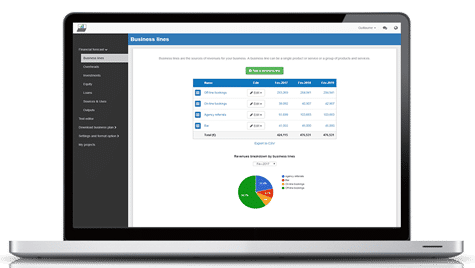How to create a financial forecast for a sunglasses line?
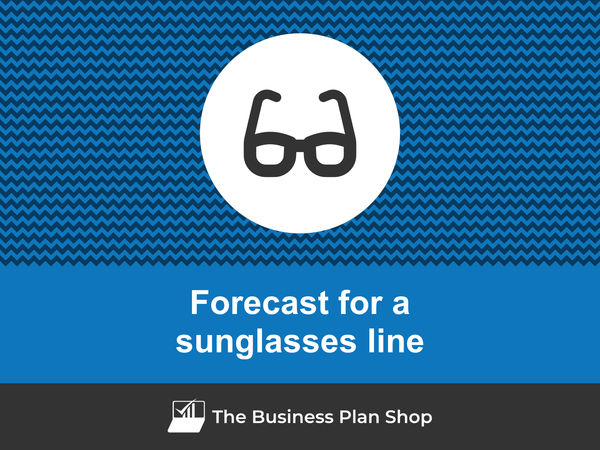
Creating a financial forecast for your sunglasses line, and ensuring it stays up to date, is the only way to maintain visibility on future cash flows.
This might sound complex, but with the right guidance and tools, creating an accurate financial forecast for your sunglasses line is not that hard.
In this guide, we'll cover everything from the main goal of a financial projection, the data you need as input, to the tables that compose it, and the tools that can help you build a forecast efficiently.
Without further ado, let us begin!
Why create and maintain a financial forecast for a sunglasses line?
The financial projections for your sunglasses line act as a financial blueprint to guide its growth with confidence and ensure its long-term financial viability.
To create them, you will need to look at your business in detail - from sales to operating costs and investments - to assess how much profit it can generate in the years to come and what will be the associated cash flows.
During challenging market conditions, maintaining an up-to-date financial forecast enables early detection of potential financial shortfalls, allowing for timely adjustments or securing financing before facing a cash crisis.
Your sunglasses line's financial forecast will also prove invaluable when seeking financing. Banks and investors will undoubtedly request a thorough examination of your financial figures, making precision and presentation essential.
Need a solid financial forecast?
The Business Plan Shop does the maths for you. Simply enter your revenues, costs and investments. Click save and our online tool builds a three-way forecast for you instantly.
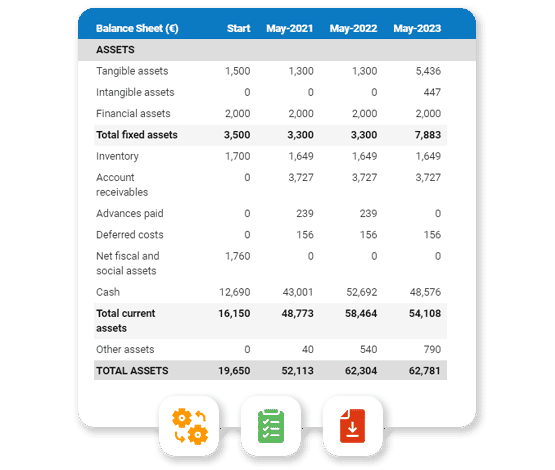
What information is used as input to build a sunglasses line financial forecast?
A sunglasses line's financial forecast needs to be built on the right foundation: your assumptions.
The data required to create your assumptions will depend on whether you are a new or existing sunglasses line.
If you are creating (or updating) the forecast of an existing sunglasses line, then your main inputs will be historical accounting data and operating metrics, and your team’s view on what to expect for the next three to five years.
If you are building financial projections for a new sunglasses line startup, you will need to rely on market research to form your go-to-market strategy and derive your sales forecast.
For a new venture, you will also need an itemised list of resources needed for the sunglasses line to operate, along with a list of equipment required to launch the venture (more on that below).
Now that you understand what is needed, let’s have a look at what elements will make up your sunglasses line's financial forecast.
The sales forecast for a sunglasses line
From experience, it usually makes sense to start your sunglasses line's financial projection with the revenues forecast.
The inputs used to forecast your sales will include the historical trading data of your sunglasses line (which can be used as a starting point for existing businesses) and the data collected in your market research (which both new ventures and existing businesses need to project their sales forward).
Your sunglasses line's sales forecast can be broken down into two key estimates:
- The average price
- The number of monthly transactions
To assess these variables accurately, you will need to consider the following factors:
- Seasonal trends: As a sunglasses line, your sales may be affected by seasonal trends, with higher demand during the summer months and lower demand during the winter months. This can impact your average price and number of monthly transactions as customers may be willing to pay more for sunglasses during peak season.
- Fashion trends: The ever-changing fashion trends can also affect your average price and number of monthly transactions. Keeping up with popular styles and designs can attract more customers and allow you to charge higher prices, while outdated styles may result in lower sales.
- Competition: The level of competition in the sunglasses market can influence your average price and number of monthly transactions. If there are many similar brands and styles available, customers may have more options to choose from and be less willing to pay higher prices. On the other hand, if your brand is unique and in high demand, you may be able to charge higher prices and experience higher sales.
- Economic conditions: Economic factors, such as inflation and unemployment rates, can also impact your business's average price and number of monthly transactions. During times of economic downturn, customers may be more price-sensitive and opt for cheaper sunglasses, while in times of economic growth, they may be more willing to spend on luxury items like sunglasses.
- Celebrities and influencers: The endorsement and promotion of your sunglasses line by popular celebrities and influencers can have a significant impact on your average price and number of monthly transactions. If a celebrity is seen wearing your sunglasses, it can increase their desirability and perceived value, allowing you to charge higher prices and attract more customers.
Once you have a sales forecast in place, the next step will be to work on your overhead budget. Let’s have a look at that now.
Need inspiration for your business plan?
The Business Plan Shop has dozens of business plan templates that you can use to get a clear idea of what a complete business plan looks like.

The operating expenses for a sunglasses line
The next step is to estimate the costs you’ll have to incur to operate your sunglasses line.
These will vary based on where your business is located, and its overall size (level of sales, personnel, etc.).
But your sunglasses line's operating expenses should normally include the following items:
- Staff Costs: This includes salaries and benefits for employees such as designers, sales staff, and customer service representatives.
- Accountancy Fees: You will need to hire an accountant or accounting firm to handle your financial records and tax filings.
- Insurance Costs: It is important to have insurance to protect your business in case of accidents, theft, or other unforeseen events.
- Software Licences: You may need to purchase software licenses for programs such as graphic design software, inventory management software, or point-of-sale systems.
- Banking Fees: This includes fees for processing credit card transactions, wire transfers, and other banking services.
- Inventory Costs: You will need to purchase sunglasses from suppliers to sell in your line, and this will be a significant expense.
- Marketing and Advertising Expenses: In order to promote your sunglasses line, you will need to budget for marketing and advertising costs such as social media ads, influencer collaborations, and print advertisements.
- Rent or Lease Payments: If you have a physical storefront or office space, you will need to budget for rent or lease payments.
- Utilities: This includes expenses for electricity, water, and other utilities needed to run your business.
- Packaging and Shipping Costs: You will need to purchase packaging materials and pay for shipping costs when sending out orders to customers.
- Travel Expenses: If you plan on attending trade shows or meeting with suppliers, you will need to budget for travel expenses such as airfare, hotel accommodations, and transportation.
- Website Maintenance and Hosting Fees: If you have an e-commerce website for your sunglasses line, you will need to pay for maintenance and hosting fees.
- Professional Services: This can include fees for legal advice, consulting services, or graphic design services.
- Office Supplies and Equipment: You will need to purchase supplies such as stationery, printer ink, and office furniture for your business.
- Taxes and Licenses: You will need to pay taxes and obtain necessary business licenses to legally operate your sunglasses line.
This list is not exhaustive by any means, and will need to be tailored to your sunglasses line's specific circumstances.
What investments are needed to start or grow a sunglasses line?
Once you have an idea of how much sales you could achieve and what it will cost to run your sunglasses line, it is time to look into the equipment required to launch or expand the activity.
For a sunglasses line, capital expenditures and initial working capital items could include:
- Equipment: This includes the purchase of machinery, tools, and equipment necessary for the production of sunglasses. Examples include cutting machines, gluing machines, and polishing machines.
- Inventory: The cost of purchasing raw materials and supplies needed to create the sunglasses, such as frames, lenses, and packaging materials.
- Store Fixtures: The cost of purchasing and installing store fixtures to display and showcase the sunglasses, such as shelves, racks, and display cases.
- Production Facility: This includes the cost of renting or purchasing a production facility where the sunglasses will be manufactured. This may also include renovations or improvements to the facility.
- Transportation: The cost of purchasing vehicles or hiring a transportation company to transport the sunglasses from the production facility to retail locations or distribution centers.
Again, this list will need to be adjusted according to the specificities of your sunglasses line.
Need a convincing business plan?
The Business Plan Shop makes it easy to create a financial forecast to assess the potential profitability of your projects, and write a business plan that’ll wow investors.
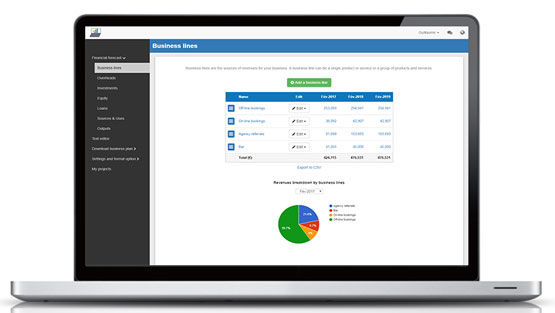
The financing plan of your sunglasses line
The next step in the creation of your financial forecast for your sunglasses line is to think about how you might finance your business.
You will have to assess how much capital will come from shareholders (equity) and how much can be secured through banks.
Bank loans will have to be modelled so that you can separate the interest expenses from the repayments of principal, and include all this data in your forecast.
Issuing share capital and obtaining a bank loan are two of the most common ways that entrepreneurs finance their businesses.
What tables compose the financial plan for a sunglasses line?
Now let's have a look at the main output tables of your sunglasses line's financial forecast.
The projected profit & loss statement
The projected profit & loss shows how profitable your sunglasses line is likely to be in the years to come.

For your sunglasses line to be financially viable, your projected P&L should ideally show:
- Sales growing above inflation (the higher the better)
- Profit margins which are stable or expanding (the higher the better)
- A net profit at the end of each financial year (the higher the better)
This is for established sunglasses lines, there is some leniency for startups which will have numbers that will look a bit different than existing businesses.
The projected balance sheet
Your sunglasses line's projected balance sheet provides a snapshot of your business’s financial position at year-end.
It is composed of three types of elements: assets, liabilities and equity:
- Assets: represent what the business possesses including cash, equipment, and accounts receivable (money owed by clients).
- Liabilities: represent funds advanced to the business by lenders and other creditors. They include accounts payable (money owed to suppliers), taxes payable and loans from banks and financial institutions.
- Equity: is the combination of what has been invested by the business owners and the cumulative profits and losses generated by the business to date (which are called retained earnings). Equity is a proxy for the value of the owner's stake in the business.

The cash flow projection
The cash flow forecast of your sunglasses line will show how much cash the business is expected to generate or consume over the next three to five years.

There are multiple ways of presenting a cash flow forecast but from experience, it is better to organise it by nature in order to clearly show these elements:
- Operating cash flow: how much cash is generated by the sunglasses line's operations
- Investing cash flow: what is the business investing to expand or maintain its equipment
- Financing cash flow: is the business raising additional funds or repaying financiers (debt repayment, dividends)
Your cash flow forecast is the most important element of your overall financial projection and that’s where you should focus your attention to ensure that your sunglasses line is adequately funded.
Note: if you are preparing a financial forecast in order to try to secure funding, you will need to include both a yearly and monthly cash flow forecast in your sunglasses line's financial plan.
Need a solid financial forecast?
The Business Plan Shop does the maths for you. Simply enter your revenues, costs and investments. Click save and our online tool builds a three-way forecast for you instantly.

Which tool should you use to create your sunglasses line's financial projections?
Building a sunglasses line financial forecast is not difficult provided that you use the right tool for the job. Let’s see what options are available below.
Using online financial forecasting software to build your sunglasses line's projections
The modern and easiest way is to use an online financial forecasting tool such as the one we offer at The Business Plan Shop.
There are several advantages to using specialised software:
- You can easily create your financial forecast by letting the software take care of the financial calculations for you without errors
- You have access to complete financial forecast templates
- You get a complete financial forecast ready to be sent to your bank or investors
- You can easily track your actual financial performance against your financial forecast, and recalibrate your forecast as the year goes by
- You can create scenarios to stress test your forecast's main assumptions
- You can easily update your forecast as time goes by to maintain visibility on future cash flows
- You have a friendly support team on standby to assist you when you are stuck
- It’s cost-efficient and much cheaper than using an accountant or consultant (see below)
If you are interested in this type of solution, you can try our projection software for free by signing up here.
Hiring a financial consultant or chartered accountant
Hiring a consultant or chartered accountant is also an efficient way to get a professional sunglasses line financial projection.
As you can imagine, this solution is much more expensive than using software. From experience, the creation of a simple financial forecast over three years (including a balance sheet, income statement, and cash flow statement) is likely to start around £700 or $1,000 excluding taxes.
The indicative estimate above, is for a small business, and a forecast done as a one-off. Using a financial consultant or accountant to track your actuals vs. forecast and to keep your financial forecast up to date on a monthly or quarterly basis will naturally cost a lot more.
If you choose this solution, make sure your service provider has first-hand experience in your industry, so that they may challenge your assumptions and offer insights (as opposed to just taking your figures at face value to create the forecast’s financial statements).
Why not use a spreadsheet such as Excel or Google Sheets to build your sunglasses line's financial forecast?
Creating an accurate and error-free sunglasses line financial forecast with a spreadsheet is very technical and requires a deep knowledge of accounting and an understanding of financial modelling.
Very few business owners are financially savvy enough to be able to build a forecast themselves on Excel without making mistakes.
Lenders and investors know this, which is why forecasts created on Excel by the business owner are often frowned upon.
Having numbers one can trust is key when it comes to financial forecasting and to that end using software is much safer.
Using financial forecasting software is also faster than using a spreadsheet, and, with the rise of artificial intelligence, software is also becoming smarter at helping us analyse the numbers to make smarter decisions.
Finally, like everything with spreadsheets, tracking actuals vs. forecasts and keeping your projections up to date as the year progresses is manual, tedious, and error-prone. Whereas financial projection software like The Business Plan Shop is built for this.
Need a convincing business plan?
The Business Plan Shop makes it easy to create a financial forecast to assess the potential profitability of your projects, and write a business plan that’ll wow investors.

Use our financial projection templates for inspiration
The Business Plan Shop has dozens of financial forecasting templates available.
Our examples contain both the financial forecast, and a written business plan which presents, in detail, the company, the team, the strategy, and the medium-term objectives.
Whether you are just starting out or already have your own sunglasses line, looking at our template is always a good way to get ideas on how to model financial items and what to write when creating a business plan to secure funding.
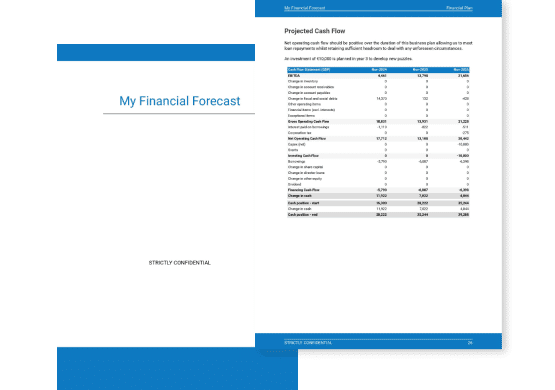
Takeaways
- A financial forecast shows expected growth, profitability, and cash generation metrics for your sunglasses line.
- Tracking actuals vs. forecast and having an up-to-date financial forecast is key to maintaining visibility on your future cash flows.
- Using financial forecasting software is the modern way of creating and maintaining financial projections.
We hope that this guide helped you gain a clearer perspective on the steps needed to create the financial forecast for a sunglasses line. Don't hesitate to contact us if you have any questions!
Need inspiration for your business plan?
The Business Plan Shop has dozens of business plan templates that you can use to get a clear idea of what a complete business plan looks like.

Also on The Business Plan Shop
Know someone who runs a sunglasses line? Share our business guide with them!

